The first Cyclamen hederifolium are already in flower and letting us know that autumn isn’t far off. Although I love their coil from bare earth, their arrival always triggers a pang of melancholy. Surely it cannot already be this time and summer already waning ?
In truth I find August one of the most difficult of months and always have, time showing in the garden where you haven’t quite got it right or where you haven’t built in a degree of expectation to keep the energy up. Knowing myself, I have learned to not give the mood purchase and plan for it with an undercurrent of asters and a stride of late-flowering grasses that still have energy in them and are yet to come into their own.
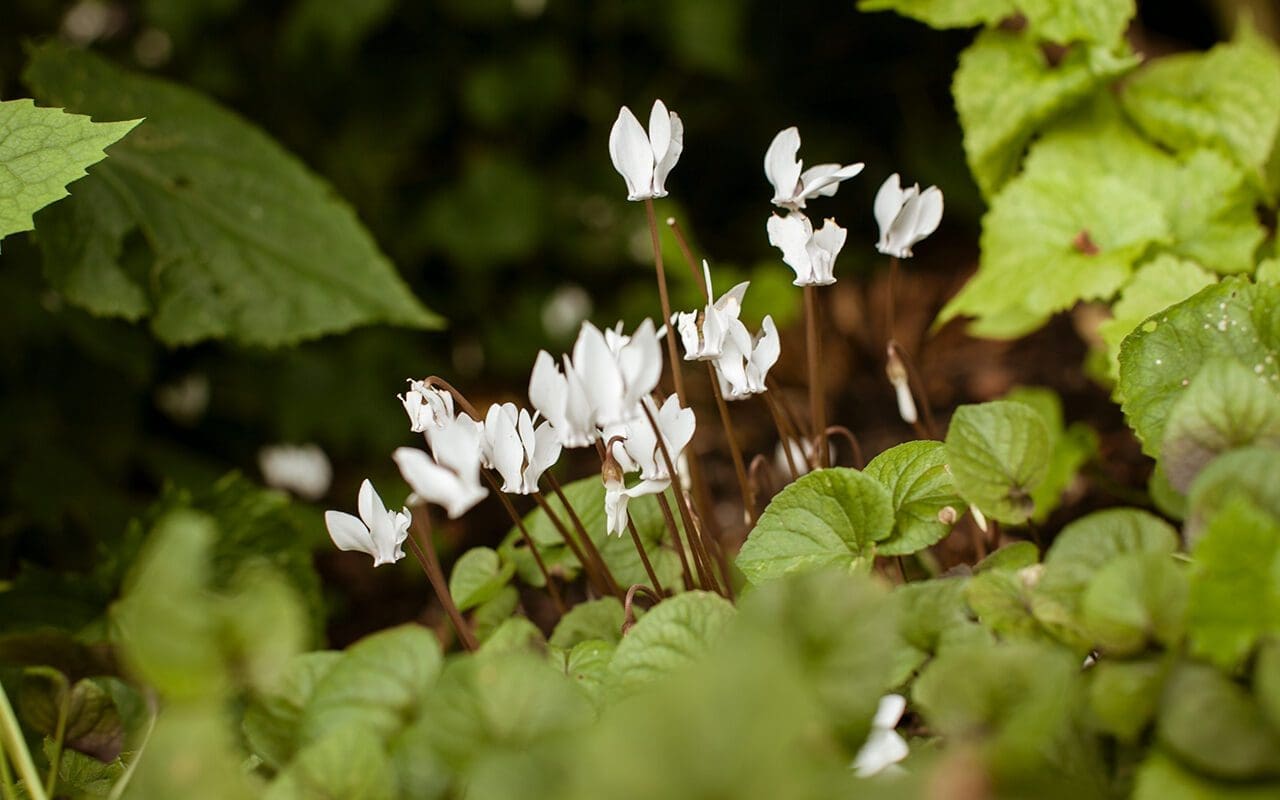
Where we leave the meadows long on the banks beneath the house, they have mostly run to seed and lie akimbo after summer storms. Wild carrot, a good latecomer and a reason to leave the meadows long until the end of the month in places, offer their flat creamy heads for the wealth of life that still occupies this place. The late cut allows for the last of the scabious, the knapweed and the late-blooming wild origanum and I have added to the banks with a slow but measured introduction of everlasting peas.
Lathyrus latifolius is a long-lived perennial usually seen in a bright magenta and often taking hold on the sunny sides of railway embankments. Perhaps these plants, often seen with running asters, were originally an escapee, hurled over a fence for being too vigorous in garden company. They could just as easily have been flung over the fence naturally, their seedpods splitting on a hot day, cracking open and catapulting their contents.
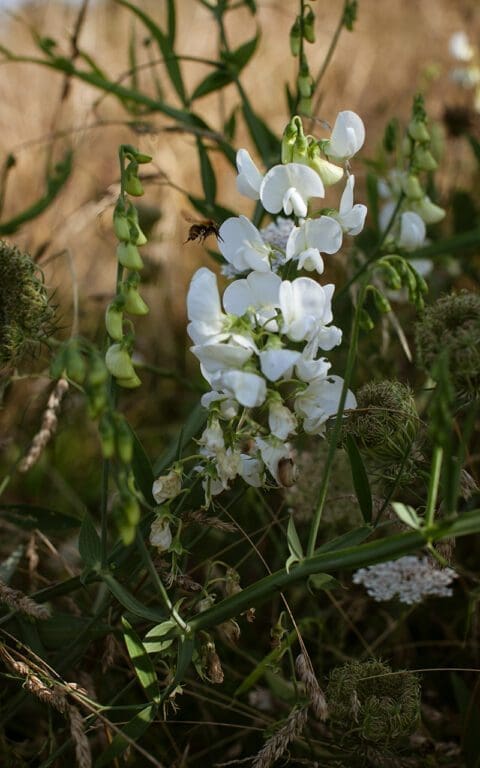
I have ‘White Pearl’, a clean creamy form here and I plan for there to be a flotsam of lathyrus to sit amongst the choppy hollows of the spent meadows. I plant twenty or so every year, which I raise from seed to extend their domain. You have to get to the seed as the pods dry and brown, but before they rupture and the seeds are jettisoned. Sown fresh they are often up in the autumn to overwinter in the frame to be the right size to plant out the following spring.
Being nitrogen fixing, the peas are happy to take to poor ground and where the company isn’t too vigorous on the dry banks they rise up and take hold as the meadows around them begin to fade. We have the narrow-leaved everlasting pea, Lathyrus sylvestris here also. The seed originally came as a gift from my friend Jane who collected it on the cliffs above Branscombe Bay in Devon. Though it is naturalised in many parts of Britain it is speculated that it wasn’t also an escapee originally. It is a pretty thing with small flowers of a dull rose-pink and growth that reminds me of a stick insect. Long, straight limbs to rise up and above the competition and tendrils that allow it to attach and suspend itself in a scaffolding of growth using nothing more than the spent stems of the grasses to provide purchase. Touch the plant and you can feel how structural its cage of growth becomes despite its delicate appearance.
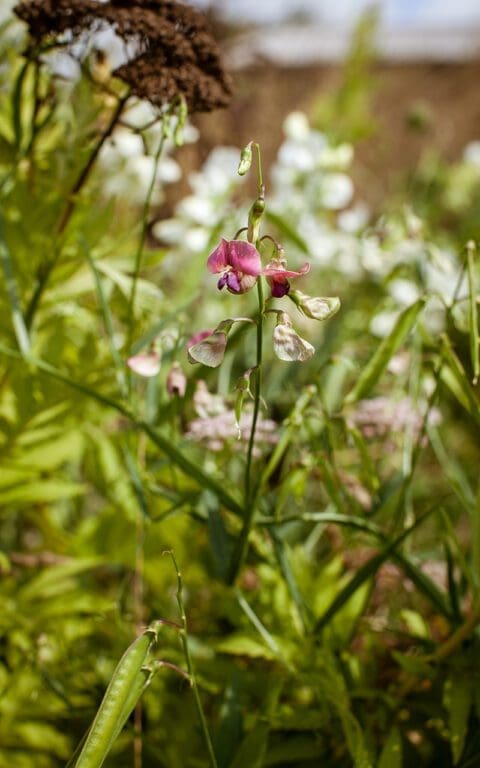
I would not plant either pea in the garden for fear of being over-run, as they are more than capable of growing to 2 metres in a season. Neither have scent, but this is a small price to pay for such a welcome interlude in the high and teetering summer.
Words: Dan Pearson | Photographs: Huw Morgan
Published 7 August 2021
Nothing smells like early summer quite like a sweet pea. Fresh and intoxicating, innocent and sensual in equal measure. The scent of my grandparent’s garden, which wafted through the windows of my bedroom on hot summer nights in Swansea. The vines planted at the ends of the runner bean supports, which brought the sweet peas down to earth while exalting the beans. They were never cut for the house, just allowed free reign to scramble and scent the vegetable patch. Now that I grow my own the house is filled with their scent as long as I can keep up with picking them, although there is always a point in the summer where the stems get so short or you have better things to do (like bottling tomatoes, freezing soft fruit, making jams and chutneys) that it is finally better to leave them on the plant and allow them their natural decline.
This year, for the first time we got our sweet pea seeds sown early. Before the arrival of the polytunnel we had always waited until late March before sowing, but we got a head start this year and planted them in early-February. The seeds were soaked in cold water overnight, which is reputed to make them faster to germinate, although it is difficult to ascertain whether this is the case or not. Three seeds of each were sown in a 9cm pot with two pots of each variety and put into our unheated toolshed, which has the frost kept from it by virtue of also being where the boiler is located. When we posted news of the seed sowing on Instagram some queried why we weren’t using root trainers and, although it is true that all legumes tend to benefit from deep pots due to their searching root growth, we have never had an issue with pot-grown sweet peas, as long as you get them in the ground before they become pot-bound. That said we have been collecting the insides of our toilet rolls to use next year to see if it makes a difference.
As soon as the seeds started to germinate they went into the Milking Barn, where we have a dedicated propagation shelf set up in the picture window, which gets direct light for most of the day. A week after germination, to prevent them becoming etiolated, I would ferry them down to the polytunnel every morning to get as much light as possible, before bringing them back up to the heated barn every evening. By early March the polytunnel was warm enough to leave them in there overnight and soon they were large enough – with four sets of true leaves – to pinch out the tops, which encourages strong root growth and stockier plants.
Once the seedlings had reached a height of 15cm they were brought up to the cold frames by the barns and hardened off for a week before planting out. However, this was delayed by the prolonged frosts in late March and early April and so, when we did eventually get them in the ground in the second week of April, they were protected with fleece for a few days until the cold snap had passed. Sweet peas are hardier then they look and although one frost was hard enough to get through the fleece, despite their wilted appearance the plants recovered very quickly.
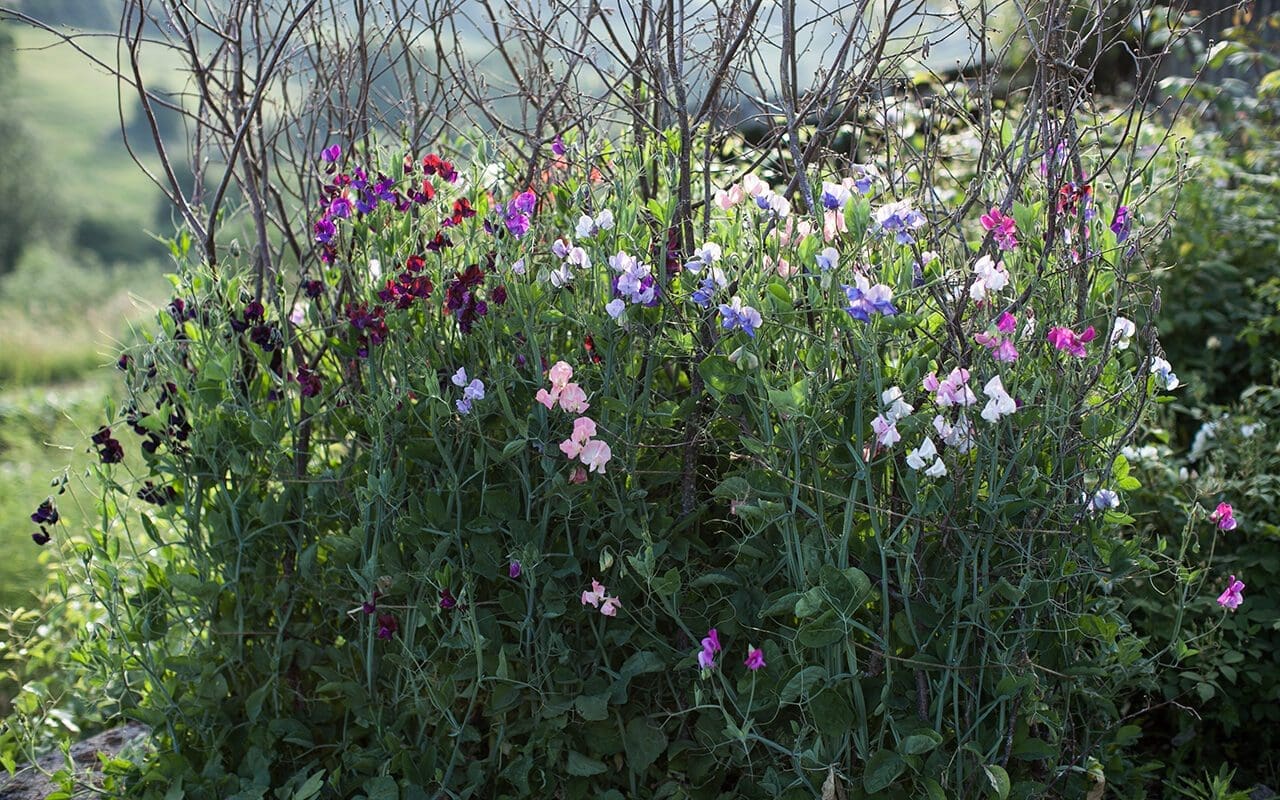
We have grown sweet peas every year since we moved here and have tried a wide range of varieties, but we always return to the Old Fashioneds and Grandifloras. These are the smaller flowered varieties, many of which are very old, and which have the strongest scent. They have a tendency to shorter stems, which means that they are not so popular with flower arrangers and florists, but I simply cut longer stems from the plants with leaves and tendrils intact. The Modern Grandiflora varieties were bred in the 20th century to provide the scent of the old varieties with the larger flowers and longer stem length of the more popular Spencer types, which have large, more ruffled flowers and long stems, but little scent. As with roses there seems little point in growing sweet peas unless they overpower with perfume.
I’ve tried several of the text book methods for prolonging the flowering season, including one year following the wisdom of the professionals and pinching out every single side shoot to encourage upward growth which, when it reaches the top of the hazel poles, is then trained down the neighbouring pole to double the height of the plant and, therefore, the number of flowers it produces. All very educational, but frankly life’s too short. Now I simply ensure that each time I pick a flower (and regular, daily, picking is the best way to ensure longevity) I snip out the side shoot that develops at its base, as the energy required for these prevents the main stem from reaching its full height and the flowers produced on them always have much shorter stems.
Each year we plant a range of colours and, although we have some stalwart favourites like ‘Cupani’, ‘Painted Lady’, ‘Almost Black’ and ‘Lord Nelson’, we always trial some new varieties. Here is this year’s selection.
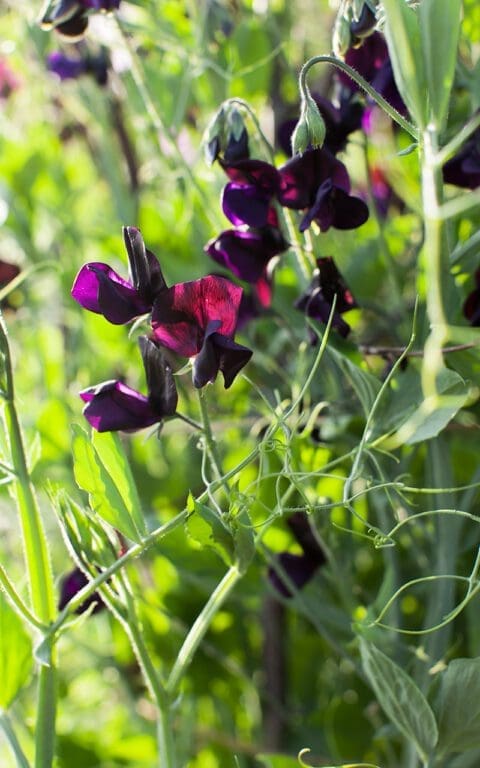
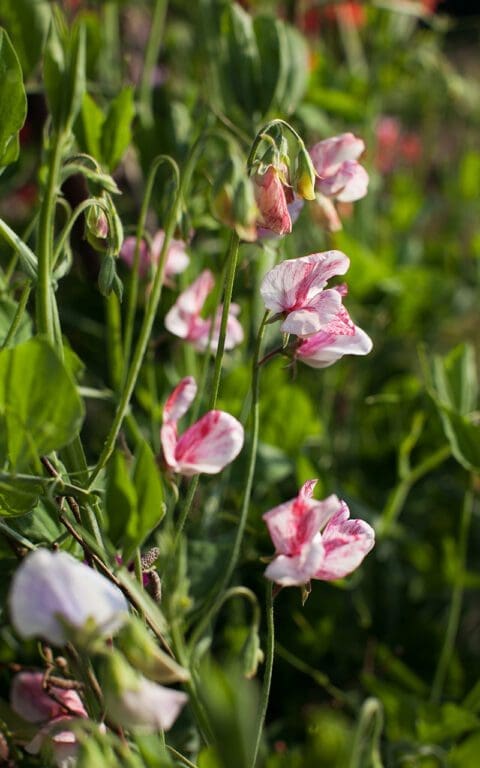
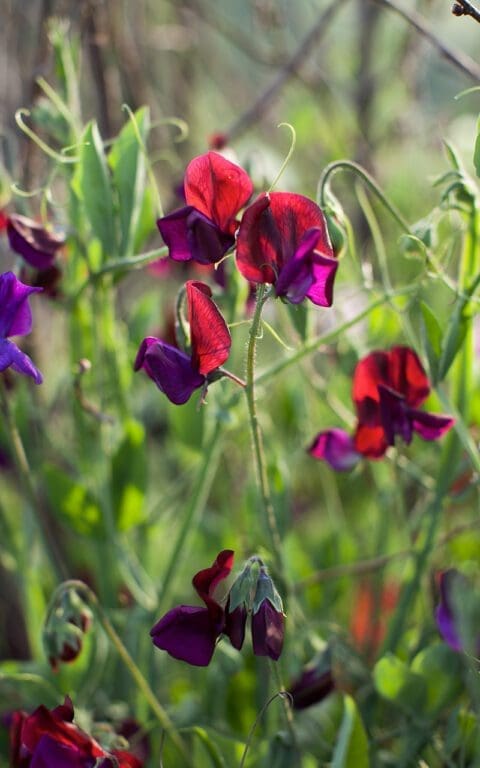
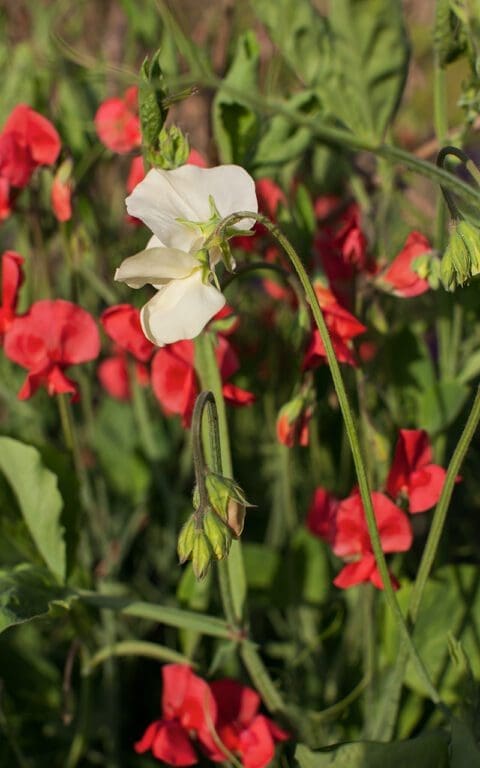
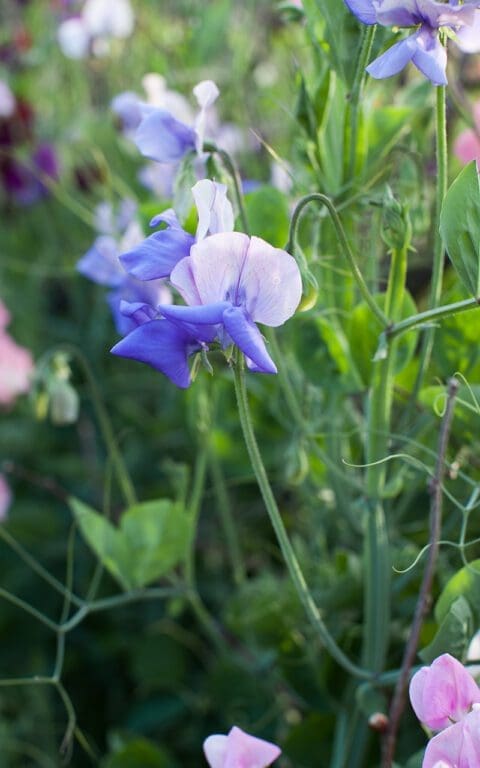
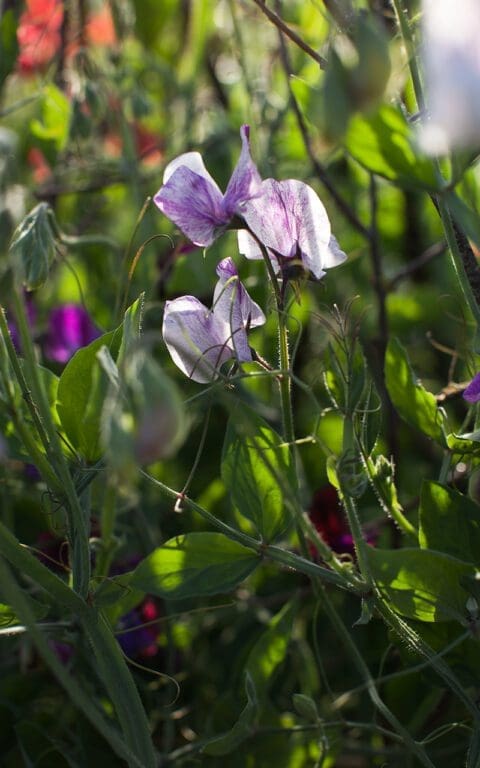
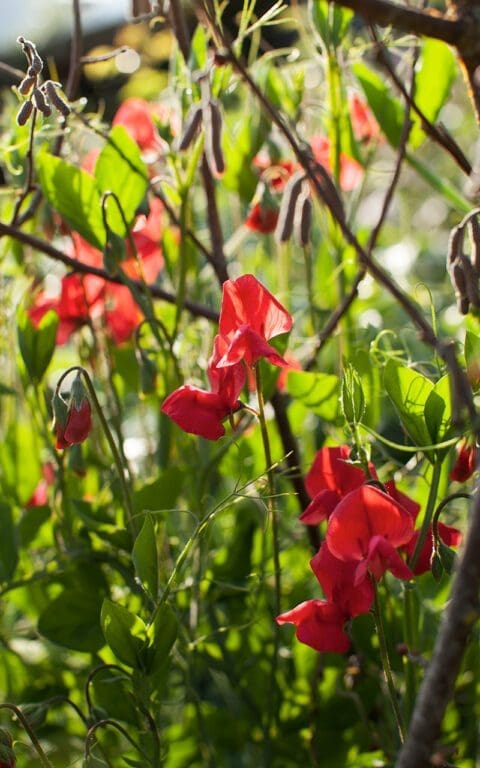
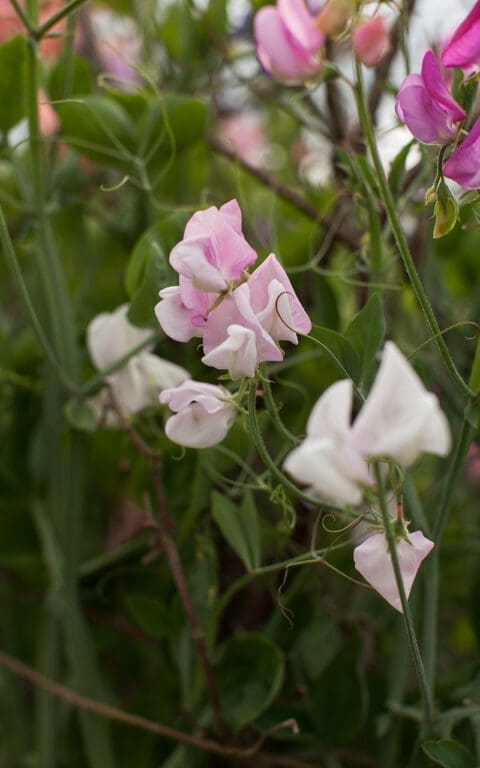
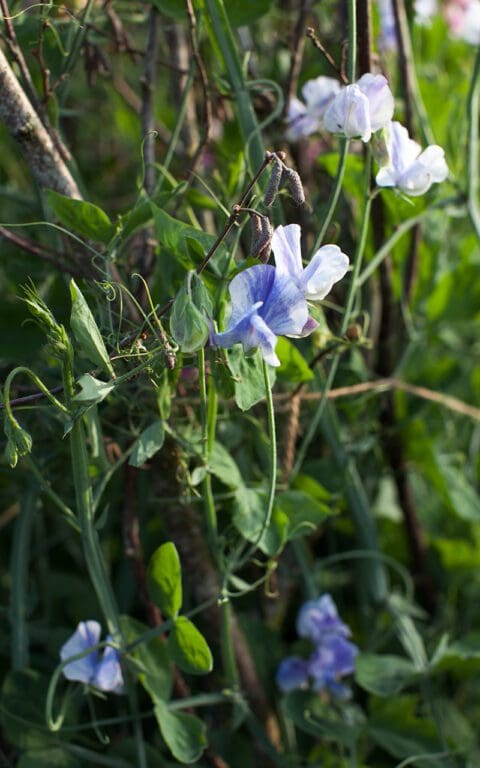
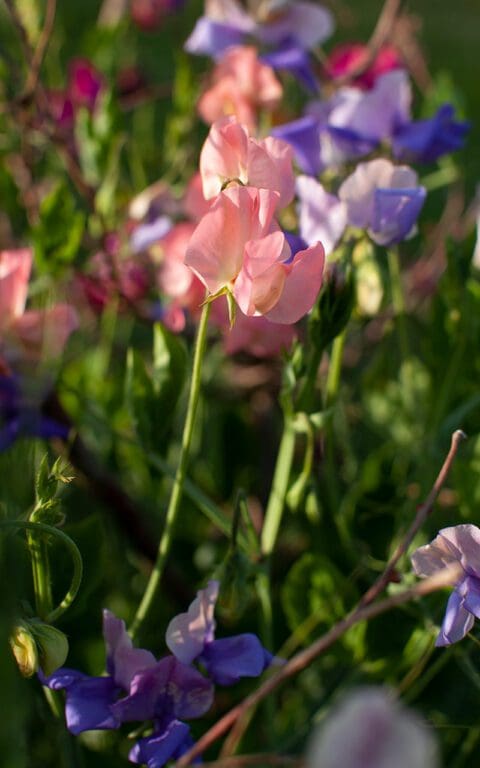
Words and photographs: Huw Morgan
Published 26 June 2021
The sweet peas are an investment. A good one with the promise of marking summertime, but one that is not without a requirement for continuity and a little-and-often attention. The rounded, manageable seed is easy. A finger pushed into compost and three seeds per pot for good measure. Sown either in the autumn and overwintered in the frame for a little protection for the strongest plants and earliest flower or, alternatively, at the first glimmer of spring in February. You have to watch if the mice are not to eat the freshly sown seed before it has even germinated and, although perfectly hardy, they like good living once ready to go out in April. They require good ground, with manure or compost and plenty of moisture to send their searching growth up into a carefully managed cage of supports. We use hazel twiggery from the coppice here. Helping their ascent, so that their soft tendrils are trained within easy reach for picking, another part of the daily vigil. And finally, once they start to bloom, you need to keep on picking to keep the flowers coming if they are not to go to seed.
All in all the rewards are forever worth it and the jug sitting beside me, with the whole room perfumed of summertime is testament. Their vibrancy is the personification of long days spent outside doing and the elongated evenings that stretch ahead until bedtime. We spend this valuable time looking and find the evenings and early morning the best time to pick them, for the cool flushes their flower and helps in keeping for longer. The evening bunch for the bedside and the morning bunch for the kitchen table. Pick and you can keep on picking every other day and, when the plants finally begin to run out of energy in August, you will be sure to feel the next season coming. The weight of harvest and in the case of the Lathyrus, the desire to go to seed, which we make allowance for when the stems get too short to pick so that we can save some.
We grow two batches of sweet peas now. Named varieties of the Old Fashioned sweet peas, which we buy new every year from Roger Parsons and Johnson’s. Selected for their perfume and not length of stem we grow them up informal hazel wigwams in a strip of land we call the cutting garden. These are an ever-changing selection as we add to and subtract from a variable list as we move through new varieties and revisit ones we’ve grown to love. These selections have plenty of Lathyrus odoratus blood coursing through their veins and we like the fact that you can feel the parent and that they have not been overbred at the expense of their stem length, flower size or perfume.
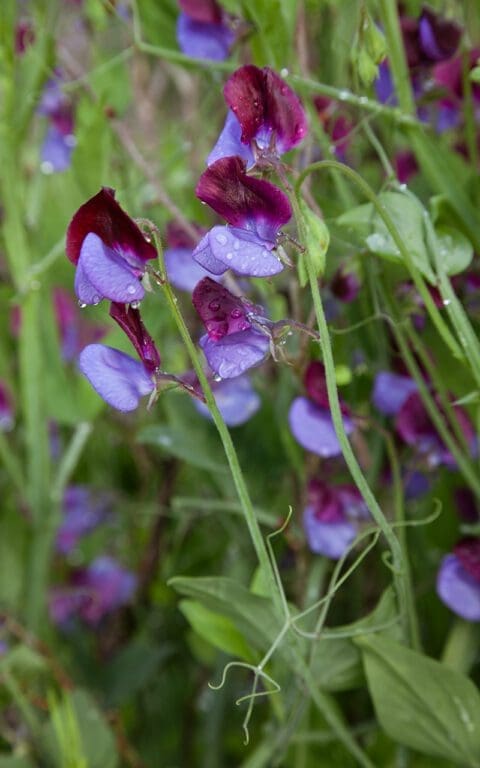
Set to one side and grown amongst the perennials in the main garden are the pure Lathyrus odoratus. We keep them apart because the seed was collected by the plantsman and painter Cedric Morris on one of his journeys to Sicily. The direct line has been carefully handed down to custodians who knew the importance of continuity. First, directly from Cedric to his friend Tony Venison, former Gardens Editor of Country Life, and then from Tony to his friend Duncan Scott. Meeting Duncan was a chance happening, as he is the neighbour of a client who thought we should connect. Duncan knew of my friendship with Beth Chatto, who in turn had learned directly from Cedric and had many of his plants in her nursery.
Duncan’s seed was handed over in a brown paper bag with the inscription ‘Cedric’s Pea. Lathyrus odoratus, collected in Sicily’. In turn I have recently had the pleasure of sending seed on to Bridget Pinchbeck who has taken on the responsibility of restoring Benton End, Cedric’s house and garden in Suffolk, to become a creative outpost of The Garden Museum. A full circle made in not too many leaps of the gardeners’ weave and easy generosity.
I am very happy to help keep the line alive and to pass it on, as we have spent much time looking through Cedric’s eyes over the years. First with plants that Morris gave with stories of their provenance to Beth Chatto and her in turn to me. And then through his dusky almost-grey and pink selections of Papaver rhoeas and latterly his Benton Iris which we grow here and treasure. Lathyrus odoratus was first introduced in 1699 by the monk Francis Cupani, the name which you will often find the pea listed under. I wonder whether Morris made his trip to Sicily in Cupani’s footsteps to find the pea for himself ? Regardless, it is good to imagine the find and relive his undoubted excitement at it. The vibrancy of the flower, with its vivid coupling of purple falls, wine red standards and the halo of unmistakable perfume.
It is Cedric’s lathyrus which is the first of our sweet peas to flower. A whole two weeks earlier than the named varieties and still the most perfumed of all. When we walk the garden in the late half-light of June, it is with an invisible orbit of scent that stops you on the path. The late light or early morning are the best times to see their colour. Clear and sumptuous and well worth the effort of continuity.
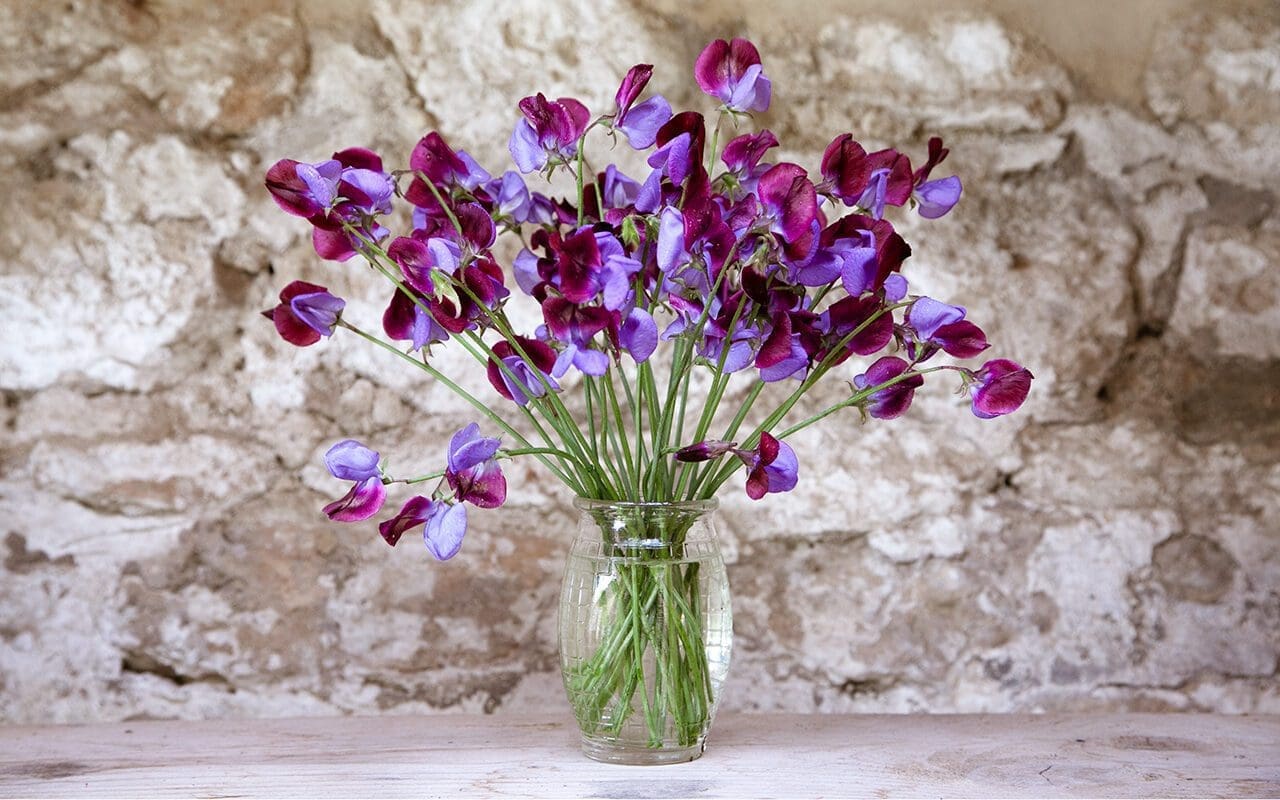
Words: Dan Pearson | Photographs: Huw Morgan
Published 19 June 2020
We are sorry but the page you are looking for does not exist. You could return to the homepage